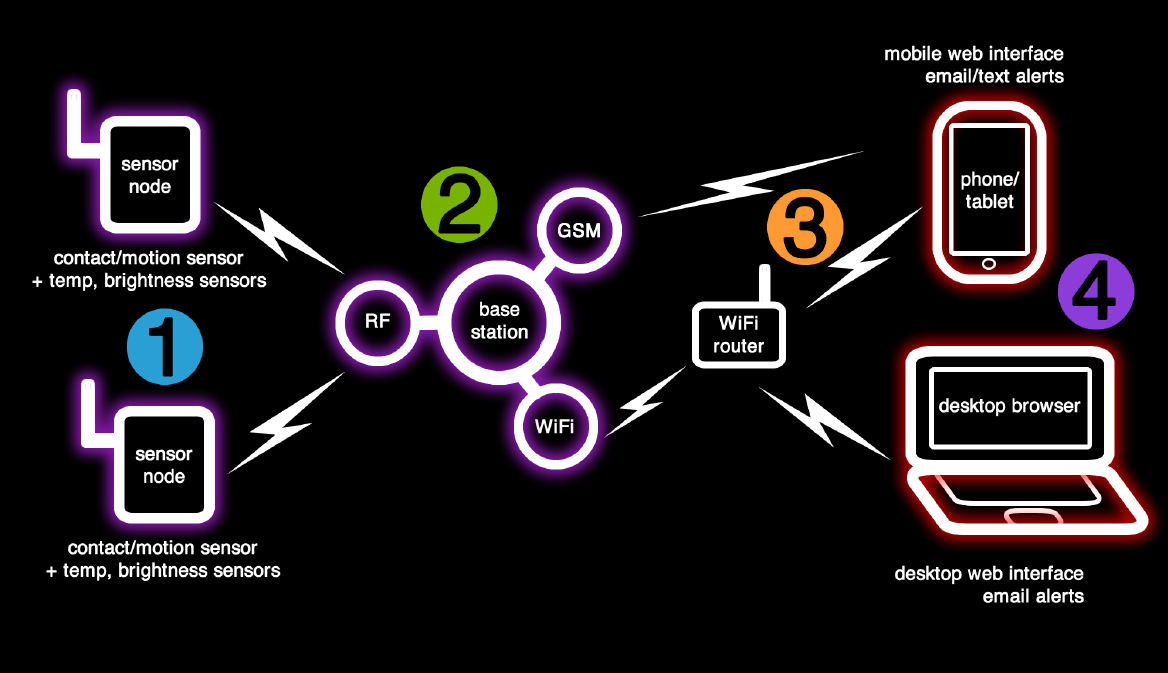Difference between revisions of "Project Advising: Remote Security System"
| Line 67: | Line 67: | ||
[[File:CmpE295A_F13_T1_system_diagram.png|x300px|center|frame|System Diagram]] | [[File:CmpE295A_F13_T1_system_diagram.png|x300px|center|frame|System Diagram]] | ||
</center> | </center> | ||
| + | |||
| + | == Team Members and Responsibilities == | ||
| + | * '''Caleb Chow''' | ||
| + | ** Sensor node (PCB, enclosure, sensors interface, software) and base station web app | ||
| + | * '''Warren Ou''' | ||
| + | ** Sensor node (PCB, enclosure, sensors interface, software) and base station web app | ||
| + | * '''Christopher Pauley''' | ||
| + | ** Base station (Nordic module interface, communication with sensor node, web app) | ||
== Requirements == | == Requirements == | ||
Revision as of 05:46, 1 December 2013
This is your wiki page that you can edit and will serve as a method of communication between us. Every week, you should add a quick status of what work got accomplished, and share any problem(s) you may encounter.
Contents
Status
Roadblocks & Problems
- Our Nordic wireless module can run on down to 1.9V and our microcontroller (p37) looks like it can run on down to 2.4V, but our motion sensor says it needs 3V to 6V. Even if the motion sensor can run at down to 2.4V, the discharge curve of the CR123A shows that they may not be good enough for our use case. And not having 3.3V limits what peripherals we can add in the future, like a camera. The battery I was looking at on Sparkfun can probably fit behind our board, but might not work either since the self-discharge rate (< 8%) may be too high. Not sure which battery to use now.
Next Goals
- Make architecture decision of Raspberry Pi vs. SJ One Board for base station.
- Get newest SJ One Board (with Nordic Wireless)
- Start to put together sensor node
- Long term: Begin designing PCB Board
Due Dates
October 4
- Journal 1
September 9
- Finish Abstract draft and present to class
Progress
| Milestone | Progress |
|---|---|
| 1 |
|
| 2 |
|
Abstract
Traditional security systems are expensive, requiring a costly installation and an exorbitant monthly fee. These costs can be prohibitive to both small business owners and homeowners, who both have limited resources to dedicate to a security system. By replacing wired sensors with user-installable wireless sensors, the cost of a professional installation can be eliminated. By substituting a call center with text alerts, a user-accessible web server, and an Android application, monthly fees can be eliminated and security can be placed into the property owner’s hands. The system will be comprised of a wireless base station, low-power wireless motion and door sensors, and a web and Android application. The base station will receive wireless transmissions from the sensors and notify the user of activity via a text alert. The user will also be able to use a web or Android application to view security reports remotely. The result of this project will be a working prototype of this wireless security system that is expandable.
Team Members and Responsibilities
- Caleb Chow
- Sensor node (PCB, enclosure, sensors interface, software) and base station web app
- Warren Ou
- Sensor node (PCB, enclosure, sensors interface, software) and base station web app
- Christopher Pauley
- Base station (Nordic module interface, communication with sensor node, web app)
Requirements
From Preet:
I've added a requirement section for you guys. Here's something to think about:
If you go with LPC1758 based base-station, you will get API to access sensor nodes out-of-the-box, but you'll have to add your own Wify interface to be able to access the system. Using this Wifi interface, you can provide a "command/response" system over TCP/IP and then any mobile application (more than one) can access the base station.
If you go with Raspberry-pi based system, you will have to add nordic wireless SPI interface to access sensor node. But once you do this, everything else will become simpler. You can host your own web-app, so no need to write separate app for android or iphone. Furthermore, you will have more power to be able to send text messages, emails etc easily since it is linux based.
I would probably pick raspberry pi, a bit more difficult to work with initially, but ultimately, more powerful.
Base Station
- Base station shall be able to communicate with each sensor node out-of-the-box
- Base station shall buffer all data from all remote sensor nodes
- Base station shall communicate over TCP/IP to provide access to its interface
Sensor Nodes
- Each sensor node shall operate from a small battery such as CR123
- Each node shall last more than one year on a single battery
- Each sensor node shall wake up periodically and send sensor data
- At minimum, there shall be motion, and door sensor
Mobile Application
- The application shall allow to arm or disarm the security system
- The application shall show events with timestamps when the system was triggered, armed, or disarmed.
